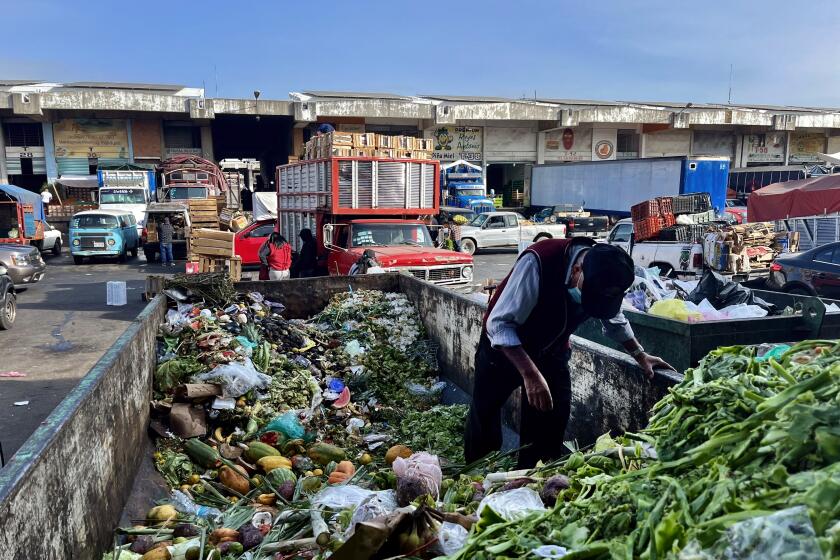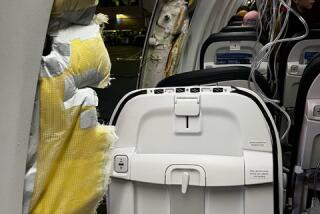‘It’s a bird! It’s a plane!’ In Alaska, it’s both, with pilot tossing turkeys to rural homes

- Share via
ANCHORAGE — In the remotest reaches of Alaska, there’s no relying on DoorDash to have Thanksgiving dinner — or any dinner — delivered. But some residents living well off the grid nevertheless have turkeys this holiday, thanks to the Alaska Turkey Bomb.
For the third straight year, a resident named Esther Keim has been flying low and slow in a small plane over rural parts of south-central Alaska, dropping frozen turkeys to those who can’t simply run out to the grocery store.
Alaska is mostly wilderness, with only about 20% of it accessible by road. In winter, many who live in remote areas rely on small planes or snowmobiles to travel any distance, and frozen rivers can act as makeshift roads.
The United Nations estimates that up to 10% of all human-produced greenhouse gases are generated by food loss and waste. That’s nearly five times the emissions from the aviation industry.
When Keim was growing up on an Alaska homestead, a family friend would airdrop turkeys to her family and others nearby for the holidays. Other times, the pilot would deliver newspapers, sometimes with a pack of gum inside for Keim.
Her family moved to more urban Alaska nearly 25 years ago but still has the homestead. Using a small plane she had rebuilt with her father, Keim launched her turkey delivery mission a few years back after learning of a family living off the land nearby who had little for Thanksgiving dinner.
“They were telling me that a squirrel for dinner did not split very far between three people,” Keim recalled. “At that moment, I thought ... ‘I’m going to airdrop them a turkey.’”
She decided not to stop there. Her effort has grown by word of mouth and by social media posts. This year, she’s delivering 32 frozen turkeys to people living year-round in cabins where there are no roads.
Black chefs across L.A. introduce us to the recipes that define their Thanksgiving holidays, including lamb biriyani, macaroni pie and carrot cake.
All but two had been delivered by Tuesday, with delivery plans for the last two birds thwarted by Alaska’s unpredictable weather.
Among the beneficiaries are Dave and Christina Luce, who live on the Yentna River about 45 miles northwest of Anchorage. They have stunning mountain views in every direction, including North America’s tallest mountain, Denali, directly to the north. But in the winter it’s a 90-minute snowmobile ride to the nearest town, which they do about once a month.
“I’m 80 years old now, so we make fewer and fewer trips,” Dave Luce said. “The adventure has sort of gone out of it.”
They’ve known Keim since she was little. The 12-pound turkey she delivered will provide more than enough for them and a few neighbors.
“It makes a great Thanksgiving,” Dave Luce said. “She’s been a real sweetheart, and she’s been a real good friend.”
Keim makes 30 to 40 turkey deliveries yearly, flying as far as 100 miles from her base north of Anchorage toward Denali’s foothills.
Caltrans data show that the Tuesday and Wednesday afternoons before Thanksgiving are the worst times to drive on the 405. A Times analysis shows when to stay off the road.
Sometimes she enlists the help of a “turkey dropper” to ride along and toss the birds out. Other times, she’s the one dropping turkeys while her friend Heidi Hastings pilots her own plane.
Keim buys about 20 turkeys at a time, with the help of donations, usually by people reaching out to her through Facebook. She wraps them in plastic garbage bags and lets them sit in the bed of her pickup until she can arrange a flight.
“Luckily it’s cold in Alaska, so I don’t have to worry about freezers,” she said.
She contacts families on social media to let them know of impending deliveries, and then they buzz the house so the homeowners will come outside.
“We won’t drop the turkey until we see them come out of the house or the cabin, because if they don’t see it fall, they’re not going to know where to look,” she said.
It can be especially difficult to find the turkey if there’s deep snow. A turkey was once missing for five days before it was found, but the only casualty so far has been a lost ham, Keim said.
The heaviest traffic in Southern California during Thanksgiving week is expected Wednesday on northbound Interstate 5 between Los Angeles and Bakersfield. Almost 80 million Americans will travel for the holiday.
Keim prefers to drop the turkey on a frozen lake if possible so it’s easy to locate.
“As far as precision and hitting our target, I am definitely not the best aim,” she joked. “I’ve gotten better, but I have never hit a house, a building, person or dog.”
Her reward is the great responses she gets from families, some who record her dropping the turkeys and send her videos and texts of appreciation.
“They just think it’s so awesome that we throw these things out of the plane,” Keim said.
Ultimately, she hopes to set up a nonprofit organization to solicit more donations and reach people across a bigger swath of the state. And it doesn’t have to stop at turkeys.
“There’s so many kids out in the villages,” she said. “It would be cool to maybe add a stuffed animal or something they can hold.”
Thiessen and Bohrer write for the Associated Press. Bohrer reported from Juneau, Alaska.
More to Read
Sign up for Essential California
The most important California stories and recommendations in your inbox every morning.
You may occasionally receive promotional content from the Los Angeles Times.














